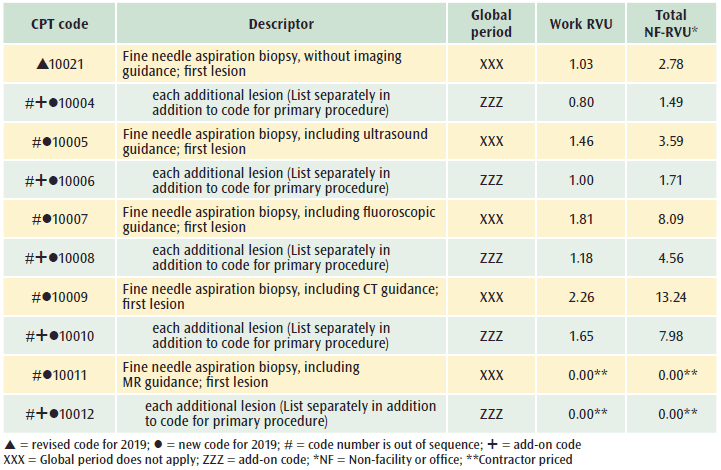Sentinel lymph node mapping
According to National Comprehensive Cancer Network Guidelines,† sentinel lymph node biopsy is now an evidence-based clinical option for staging of various gynecologic cancers. In recognition of these new guidelines, the parenthetical following code 38900 has been revised to add codes for primary and staging pelvic and vulvar procedures to the current list of codes.
+38900, Intraoperative identification (eg, mapping) of sentinel lymph node(s) includes injection of non-radioactive dye, when performed (List separately in addition to code for primary procedure)
(Use 38900 in conjunction with 19302, 19307, 38500, 38510, 38520, 38525, 38530, 38531, 38542, 38562, 38564, 38570, 38571, 38572, 38740, 38745, 38760, 38765, 38770, 38780, 56630, 56631, 56632, 56633, 56634, 56637, 56640)
Catheter-assisted vein sclerotherapy
New Category III code 0524T, Endovenous catheter directed chemical ablation with balloon isolation of incompetent extremity vein, open or percutaneous, including all vascular access, catheter manipulation, diagnostic imaging, imaging guidance and monitoring, has been added to CPT 2019 to report catheter-directed sclerosant ablation using balloon isolation of an incompetent extremity vein. This procedure differs from existing incompetent vein treatment codes in that an inflatable balloon located at the distal tip of a catheter is used to isolate the incompetent section of vein when delivering the sclerosing agent. The new code includes all diagnostic imaging and imaging guidance performed in support of the procedure. Monitoring of vascular access and catheter manipulation also is included. CPT Category III codes are temporary codes for emerging technology, services, procedures, and service paradigms to allow data collection and are not assigned RVUs.
I&D of deep soft tissue abscess
Code 20005, Incision and drainage of soft tissue abscess, subfascial (i.e., involves the soft tissue below the deep fascia), was identified by the AMA/RUC as potentially misvalued because the value for the code includes inpatient physician work, but the Medicare data indicate the procedure is performed less than 50 percent of the time in an inpatient setting. The stakeholder specialties determined that an incision and drainage (I&D) of a deep abscess is reportable with other more specific codes in the CPT code set. Therefore, deletion of code 20005 was approved for 2019.
Lower extremity multi-layer compression
Code 29581, Application of multi-layer compression system; leg (below knee), including ankle and foot, is intended to be reported for lower extremity swelling related to venous insufficiency. It is incorrect to report 29581 in conjunction with surgical treatment of incompetent veins (for example, sclerotherapy or radiofrequency vein ablation). To prevent miscoding, a parenthetical was added to the CPT code set that instructs not to report 29581 in conjunction with codes for treatment of incompetent veins (36465, 36466, 36468, 36470, 36471, 36473, 36474, 36475, 36476, 36478, 36479, 36482, and 36483) for the same extremity. It should also be noted that code 29581 should not be reported for simply wrapping the lower extremity with elastic bandages.
Appendix L–Vascular families
For CPT 2019, Appendix L has been updated to clarify the order of vessels for arterial and venous vascular branching for catheterization procedures. This model assumes the aorta, vena cava, pulmonary artery, or portal vein is the starting point of catheterization. Accordingly, branches have been categorized into first, second, third order, and beyond. Common branching patterns of typical anatomy shown in the revised chart in Appendix L are based on Gray’s Anatomy: The Anatomical Basis of Clinical Practice.‡




